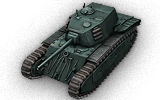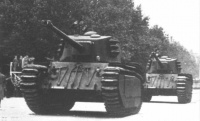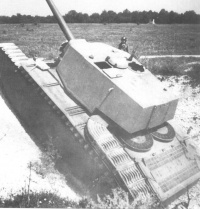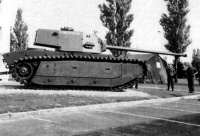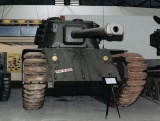ARL 44
| Revision as of 10:10, 11 January 2012 | Revision as of 12:09, 13 January 2012 | |||
| Line 45: | Line 45: | |||
| == Development history == | == Development history == | |||
| ? | [[image:ARL 44 wooden model in natural size. Finished during the occupation by | + | [[image:ARL 44 wooden model in natural size. Finished during the occupation by Nazi Germany.jpg|thumb|200px|left| ARL 44 wooden model in natural size. Finished during the occupation by Nazzi Germany]] | |
| However French pre-war light and medium designs had become completely outdated and there was no way to quickly make up for the time lost and immediately improve their component quality. It might be possible though to compensate for this by sheer size. A large and well-armed vehicle might still be useful, however obsolescent its individual parts were, especially as the British and Americans seemed to be behind Germany in heavy tank development, having no operational vehicles that could slug it out with a Tiger II. An important secondary goal of the project was simply to ensure that France would in the future have a sufficient number of weapons engineers; if these couldn't be employed now, they would be forced to seek other occupations and much expertise would be lost. | However French pre-war light and medium designs had become completely outdated and there was no way to quickly make up for the time lost and immediately improve their component quality. It might be possible though to compensate for this by sheer size. A large and well-armed vehicle might still be useful, however obsolescent its individual parts were, especially as the British and Americans seemed to be behind Germany in heavy tank development, having no operational vehicles that could slug it out with a Tiger II. An important secondary goal of the project was simply to ensure that France would in the future have a sufficient number of weapons engineers; if these couldn't be employed now, they would be forced to seek other occupations and much expertise would be lost. | |||
Revision as of 12:09, 13 January 2012
ARL 44
| France | Heavy Tank | Tier VI |
Historical Info
During the German occupation some clandestine tank development took place in France, mostly limited to component design or the building of tracked chassis with either a pretended civilian use or with a German Navy destination. These efforts were coordinated by CDM (Camouflage du Matériel), a secret Vichy army organisation trying to produce matériel forbidden by the armistice conditions, with the ultimate goal of combining these components into the design of a possible future thirty ton battle tank, armed with a 75 mm gun. The projects were very disparate, including those for a trolleybus, the Caterpillar du Transsaharien (a regular cross-Sahara track and rail connection) and a tracked snow blower for the Kriegsmarine to be used in Norway. Firms involved were Laffly and Lorraine; also a military design team in occupied France, headed by Maurice Lavirotte, was active. When in August 1944 Paris was liberated, the new provisional government of France did its utmost to regain the country's position as a great power, trying to establish its status as a full partner among the Allies by contributing as much as possible to the war effort. One of the means to accomplish this was to quickly restart tank production. Before the war France had been the world's second largest tank producer, behind the Soviet-Union.
Development history
However French pre-war light and medium designs had become completely outdated and there was no way to quickly make up for the time lost and immediately improve their component quality. It might be possible though to compensate for this by sheer size. A large and well-armed vehicle might still be useful, however obsolescent its individual parts were, especially as the British and Americans seemed to be behind Germany in heavy tank development, having no operational vehicles that could slug it out with a Tiger II. An important secondary goal of the project was simply to ensure that France would in the future have a sufficient number of weapons engineers; if these couldn't be employed now, they would be forced to seek other occupations and much expertise would be lost.
Consequently it was decided to produce 600 heavy tanks, to be designed by the Direction des Études et Fabrications d'Armement (DEFA) in which engineers from the former APX (the army Atelier de Puteaux) and AMX (the Atelier de Construction d'Issy-les-Moulineaux state factory) design teams were concentrated, and built by the Atelier de Construction de Rueil (ARL), the army workshop. The type was named ARL 44. The specifications were not at first overly ambitious and called for a thirty ton vehicle with 60 mm of armour and armed with a new 75 mm Long 44 gun, rendering a penetration of 80 mm steel at 1000 metres and developed by engineer Lafargue from the 75 mm CA 32 gun, conforming to the earlier CDM intentions.
As France had been rather isolated from engineering developments in the rest of the world, the designers based themselves on types they already knew well, mainly the Char B1, the Char G1 and the FCM F1 — contrary to what some sources state[4] the ARL 44 was not directly derived from the earlier ARL 40 project. It was tried to use the components developed between 1940 and 1944, though most soon proved to be incompatible. As a result of the reliance on older types, the ARL 44 was to be fitted with a very old-fashioned suspension system with small road wheels, using the same track as the Char B1, limiting maximum speed to about thirty km/h. The suggestion to use a more modern foreign suspension system was rejected as it would have compromised the tank's status as a purely French design. A Talbot 450 hp or Panhard 400 hp engine was envisaged. Progress was very slow as there was a lack of resources and much infrastructure in the Paris region had been destroyed. Even finding paper and drawing materials was difficult.
In February 1945 a meeting took place between the engineers and the Army. The tank officers quickly pointed out that building a tank according to the original specifications was pointless as such a vehicle would be inferior to even an M4 Sherman, a type that could be obtained for free from the Allies in any numbers so desired. It was therefore decided that the ARL 44 would be fitted with 120 mm of sloped armour, bringing the weight, which even in the conceptual stage had already grown to 43 metric tons, to 48 tons. The armament should consist of the most powerful gun available; sadly this would probably be the American 76 mm or with some luck the British 17-pounder; 90 mm guns had not been made available by the Allies.
Only a wooden mock-up had been completed by an engineering team headed by Engineer General Maurice Lavirotte, when the war ended. However, the end of hostilities did not mean the end of the entire project. To maintain some continuation in French tank design and bolster national morale, it was decided to build sixty vehicles, even though there was no longer any real tactical need for them. In March 1946 the first prototype could be tested. The Atelier et Chantiers de la Loire built the ACL1 turret, fitted with the American 76 mm gun; this was later replaced by a Schneider turret based on the one designed for the Char F1 and fitted with the 90 mm DCA naval AA-gun which had a muzzle velocity of 1000 m/s (AP; 1130 m/s HE) and a muzzle brake — the ARL 44 was thus the first French tank to feature this item. Firing trials began on 27 June 1947; the gun often proved to be more accurate than that of a Panther used for comparison.
Mainly due to the change in armament, the development and production of the turret would be drawn out; it was not until 1949 that turrets could be fitted to hulls produced in 1946 and placed into storage. Forty hulls had been completed by FAMH and a further twenty by Renault. They were fitted with captured German Maybach HL230 600 hp engines (real output 575 hp), brought back by a mission headed by General Joseph Molinié in the summer of 1945, repeating the course of events with the Char 2C, which after the previous war had also received captured Maybach engines.
Description
The ARL 44 clearly shows that it is based on earlier French heavy tank design. The hull is long, over nine metres, but relatively narrow, just as a vehicle meant to cross wide trenches. The covered suspension, with its many small road wheels, that had already been outdated in the thirties, is the most obvious sign of its basic Char B1 ancestry; it is in essence identical to that of the Char B1 ter. The type has often been compared to the many "Super Char B" projects from before the war. Its speed is likewise limited, the lowest of any fifty ton tank built after the war. This was also partly due to the lack of a sufficiently strong engine; it had originally been intended to compensate for this by using a more efficient petro-electrical transmission. This kind of transmission has as a major drawback that it very easily overheats and the ARL 44 as a result was fitted with an impressive and complex array of ventilators and cooling ducts; the engine deck was made to extend behind the track to accommodate them all. The hull glacis plate is 120 mm thick and reclined at about 45°, giving a line-of-sight thickness in the horizontal plane of about 170 mm. This made the ARL 44 the most heavily armoured French tank until the Leclerc. Within the glacis, low on the right side, a 7.5 mm machine-gun is fitted in a fixed position.
The turret was the most modern looking part; it's also an obvious makeshift solution, somewhat crudely welded together, made necessary by the simple fact Schneider as yet couldn't produce complete cast turrets large enough to hold a 90 mm gun. The turret front was a cast section though. As the turret was positioned near the middle of the tank, even when pointing to the back the gun would have a large overhang; to facilitate transport it was therefore made retractable into the turret. The turret was rotated by a Simca 5 engine.
In all, the ARL 44 was an unsatisfactory interim design, afterwards often called the "Transitional Tank", which main function was to provide experience in building heavier vehicles. The main lesson learned was for many engineers that it was unwise to construct too heavy types and this opinion was reinforced by the failure of the tank project that the ARL 44 formed the transition to: the much more ambitious heavy AMX 50. Only after a gap of sixteen years France would in 1966 again build a main battle tank, the AMX 30.
Operational history
The ARL 44s equipped the 503e Régiment de Chars de Combat stationed in Mourmelon-le-Grand and before the end of 1950 replaced seventeen Panther tanks used earlier by that unit. In service the ARL 44 was at first an unreliable vehicle: the brakes, the gear box and the suspension were too frail. A special improvement programme remedied most of these shortcomings. The ARL 44 made only one public appearance, ten vehicles participated in the Bastille Day parade on 14 July 1951. When the American M47 Patton became available, which type also had a 90 mm gun, they were phased out in 1953 and used as targets. The rumour that most ARL 44s were exported to Argentina is unfounded.
Three ARL 44s survive today. An ARL 44 can be seen in the Musée des Blindés in Saumur; another one at the 501st-503rd Tank Regiment, Mourmelon-le-Grand, a third is a wreck on the technical zone of the base of the 2nd Dragoon Regiment at Fontevraud. It is relatively complete but the gun is dismounted from the turret.
